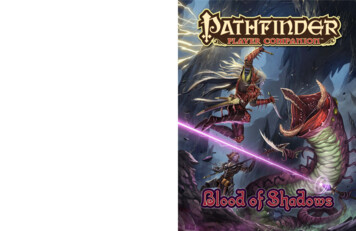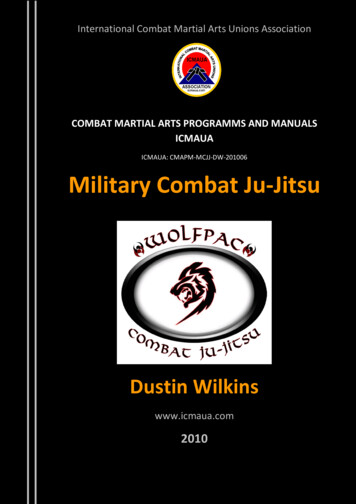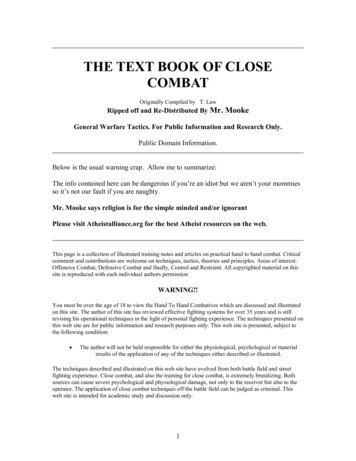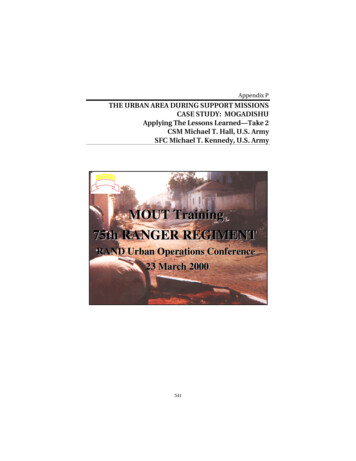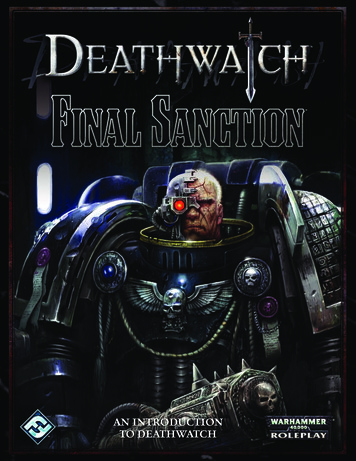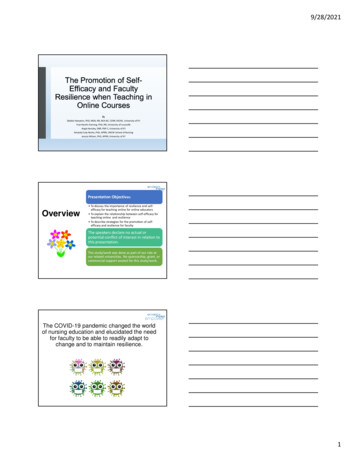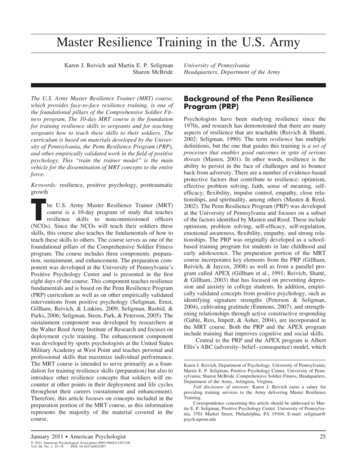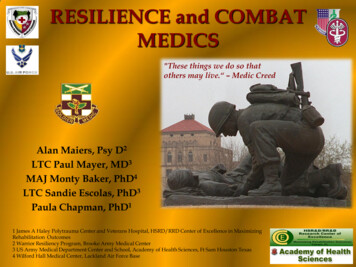
Transcription
RESILIENCE and COMBATMEDICS"These things we do so thatothers may live.“ – Medic CreedAlan Maiers, Psy D2LTC Paul Mayer, MD3MAJ Monty Baker, PhD4LTC Sandie Escolas, PhD3Paula Chapman, PhD11 James A Haley Polytrauma Center and Veterans Hospital, HSRD/RRD Center of Excellence in MaximizingRehabilitation Outcomes2 Warrior Resiliency Program, Brooke Army Medical Center3 US Army Medical Department Center and School, Academy of Health Sciences, Ft Sam Houston Texas4 Wilford Hall Medical Center, Lackland Air Force Base
Form ApprovedOMB No. 0704-0188Report Documentation PagePublic reporting burden for the collection of information is estimated to average 1 hour per response, including the time for reviewing instructions, searching existing data sources, gathering andmaintaining the data needed, and completing and reviewing the collection of information. Send comments regarding this burden estimate or any other aspect of this collection of information,including suggestions for reducing this burden, to Washington Headquarters Services, Directorate for Information Operations and Reports, 1215 Jefferson Davis Highway, Suite 1204, ArlingtonVA 22202-4302. Respondents should be aware that notwithstanding any other provision of law, no person shall be subject to a penalty for failing to comply with a collection of information if itdoes not display a currently valid OMB control number.1. REPORT DATE3. DATES COVERED2. REPORT TYPE21 MAR 201100-00-2011 to 00-00-20114. TITLE AND SUBTITLE5a. CONTRACT NUMBERResilience And Combat Medics5b. GRANT NUMBER5c. PROGRAM ELEMENT NUMBER6. AUTHOR(S)5d. PROJECT NUMBER5e. TASK NUMBER5f. WORK UNIT NUMBER7. PERFORMING ORGANIZATION NAME(S) AND ADDRESS(ES)US Army Medical Department Center and School,Academy of HealthSciences, Fort Sam Houston,TX,782349. SPONSORING/MONITORING AGENCY NAME(S) AND ADDRESS(ES)8. PERFORMING ORGANIZATIONREPORT NUMBER10. SPONSOR/MONITOR’S ACRONYM(S)11. SPONSOR/MONITOR’S REPORTNUMBER(S)12. DISTRIBUTION/AVAILABILITY STATEMENTApproved for public release; distribution unlimited13. SUPPLEMENTARY NOTES14. ABSTRACT15. SUBJECT TERMS16. SECURITY CLASSIFICATION OF:a. REPORTb. ABSTRACTc. THIS PAGEunclassifiedunclassifiedunclassified17. LIMITATION OFABSTRACT18. NUMBEROF PAGESSame asReport (SAR)4019a. NAME OFRESPONSIBLE PERSONStandard Form 298 (Rev. 8-98)Prescribed by ANSI Std Z39-18
Objectives Review the importance of studying thispopulation Describe challenges in training medics and howthey are being prepared psychologically Review literature associated with psychologicalrisk and resiliency factors of medics Describe current research being conducted withmedics Offer a research agenda for future direction
Rationale for Studying Resilience inCombat Medics Revered military role - Medal of Honor Critical to combat units Responsible for treating woundedo Soldiers and allieso civilians and enemy combatants Potentially conflicting decisions on thebattlefield Dual role (Soldier/Medic) No studies specifically on combat medics*
CHARLES CHRISHAGEMEISTER
68 WhiskeyCombat Medic TrainingLTC Paul Mayer, MDDirector, Department of Combat Medic TrainingFt Sam Houston, TX21 March, 2011
Department of Combat MedicTraining (DCMT) Provides the Army with the best trained CombatMedics Highly motivated, well disciplined, and physically& mentally fit. A multifaceted learning environmento Lectureso Demonstrationso Hands-on practical exerciseso Scenario-based trainingCombined Field TrainingExercise (CFTX)
68W Overview 2nd largest Specialty in the Army Trains over 7,500 Soldiers annuallyo 17 classes per year, with new classes startingevery 2-3 weekso Duration of 16 weekso Class size is 450, 80% maleo Service members from other branches &other countries are also trained
68W Curriculum Overview EMT-B (Emergency Medical Technician-Basic) Limited Primary Care Field Craftso “Whiskey” trainingo Simulationso Combined Field Training Exercise (CFTX)
68W Curriculum Overview:Emergency Medical Technician-Basic(EMT-B) Lasts 7 weeks The curriculum is developed by theDepartment of Transportation (DOT) Students attain Healthcare Provider CPRCertification All Graduates are NREMT-B Certified &receive the “EMT” patcho National pass rate 65%o DCMT pass rate 92%
68W Curriculum Overview:Limited Primary Care Lasts 1 week Sick call Medical documentation Pharmacology Wound care
Field Crafts Tactical Medicine(“Whiskey”) Simulation Trainingo Hands-on training onmannequins in theCombat Trauma PatientSimulator (CTPS) Combined Field TrainingExercise (CFTX)o Consists of Situational &Field Training
Field Crafts:Tactical Medicine 6 weeks Tactical Combat Casualty Care (TCCC) fundamentals Core Skillso Combat Casualty Assessment (assess injuries the patient may have)o Tourniquet (stops bleeding on extremities – arms & legs)o Hemostatic agents (stops bleeding where tourniquets cannot – neck,armpits, & groin area)o Needle Chest Decompression (relieves air/pressure from around thelungs)o Surgical Airway (allows breathing via an opening in the throat whenmajor facial damage is present)o King LT Airway (devices used to maintain an open airway)o IV & FAST-1 (allows fluids to be put into the body intravenously orthrough bone) Skills Validationo Hands-on test of overall knowledge & skills
Field Crafts:Simulation Training 116 Human PatientSimulators (HPS) HPSs allow for handson practice, which isrequired forcertification, & allowsthe students to makemistakes withoutharming anyone.
Field Crafts:Combined Field Training Exercise Lasts 2 weeks & is located at the Soldier Medic Training Site(SMTS) on Camp Bullis Consists of Situational & Field Training Exercises:o Convoy operations (reacting to ambushes while invehicles)o Patrolo MOUT (Military Operations in Urban Terrain)o BAS (Battalion Aid Station)o CBRNE (Chemical, Biological, Radioactive, Nuclear, &Explosive)o Mass casualty exercises (when medical care needsoverwhelm medical care capability)
68W Mental Health Training Behavioral Health Emergencies - 2 hours Battle Mind Resiliency Training - 3 hours Depression/Suicide Recognition andPrevention -1 Hour
Summary The lowest Killed In Action (KIA) rate isattributed to the following:o Improved Tactical Combat Casualty Careo Enhanced Personal Protective Equipmento Emphasis on Hemorrhage Controlo Improved MEDEVAC/CASEVACResponse Times
Current Knowledge on Riskand Resilience of CombatMedicsCombat Medic Mettle Study – Dr. Paula ChapmanFt Sam Study – LTC Sandra EscolasAir Force Medics Study – Maj Monty Baker
Risk and Resiliency inDeployed and Non-DeployedCombat MedicsPaula L ChapmanJames A Haley Polytrauma Center and VA HospitalTampa, FL21 March, 2011Collaborators:*Uniformed Services and Health Sciences University – MAJ DavidCabrera, Military PI*Tulane University – Charles Figley, PhD, Qualitative PI*James A Haley Polytruama Center and VA Hospital Center ofExcellence: Maximizing Rehabilitation Outcomes – Paula Chapman,PhD, Quantitative PI*Wilford Hall Medical Center, USAF - Maj Monty Baker, PhD*Warrior Resiliency Program, Brooke Army Medical Center, AlanMaiers, PsyDAMEDD C&S, LTC Sandie Escolas, PhDThe U.S. Army Medical Research Acquisition Activity, 820 Chandler Street, Fort Detrick MD 21702-5014 is theawarding and administering acquisition office for grant W81XWH-09-1-0655. Quant PI: Chapman; Military PI:Cabrera
Risk and Resiliency in CombatMedicsObjectives To determine current behavioral health statusof Army combat medics To identify risk/protective factors to predictbehavioral health outcomes among ArmyCombat Medic To create an initial model of resiliency for thedeployed Combat Medic
Risk and Resiliency in CombatMedicsMethodology 3 year, prospective, longitudinal design Three groups:o Never deployedo 3-6 months post-deployment from a 12 monthdeploymento 12 months post-deployment; not deployed in atleast 12 months Mixed methods Convenience sample from population of U.S. ArmyCombat Medics in Europe and Ft Hood
DemographicsNeverDeployed 3-6 mo PD%%(n)(n)12 )16.51(35)72.17(153)11.32(24)Marital StatusNot MarriedMarried/SeparatedDivorced3-6 mo PD%(n)12 nRaceOtherNeverDeployed%(n)High Schoolor LessSomeCollegeCollegeDegreeDeploymentDeployed toOIFDeployed toOEF
Threat, Loss & Potential MoralInjuriesThreatDid you believe you were in serious danger of being injured or killed?Deployed%(n)76.51(254)LossWas a Soldier whom you care about and whom you consider close to youseriously injured or killed?Were you wounded or injured?43.97(153)8.65(30)Potential Moral InjuriesDuring your most recent deployment, did you personally engage the enemy infire fight?Were you directly responsible for the death of an enemy combatant?Were you directly responsible for the death of civilians?27.49(94)5.76(20)1.44(5)
Experiences in CombatExperiences in CombatI or members of my unit received hostile incoming fire from small arms, artillery,rockets, mortars, or bombs.Working in areas that were mined or had IEDs.I or members of my unit were attacked by terrorists or civilians.Clearing/searching homes or buildings.I personally witnessed someone from my unit or an ally unit being seriously injured.Personally witnessed Soldiers from enemy troops being seriously wounded or killed.My unit engaged in a battle in which it suffered casualties.Shooting or directing fire at the enemy.I fired my weapon at the enemy.I killed or think I killed someone in .95(78)8.21(32)
Depression and PTSDDepression 55 to 14 15PTSD 2829 to 49 50Never Deployed%(n)68.02(151)3-6 mo PD%(n)54.71(186)12 mo PD%(n)63.21(122)28.38*(63)3.60(8)38.82* (132)6.47(22)32.12 (62)4.66(9)Never Deployed%(n)83.33(185)3-6 mo PD%(n)65.59(223)12 mo 0(8)8.53(29)6.74(13)
Mental Health ServicesMental Health ServicesMental health professional?Combat stress control professional?General medical doctor?Military chaplain?Medic in your unit?Soldier in your 8(22)1.69(4)2.11(5)3-6 mo 4.60(16)12 mo 81(10)
Risk and Resiliency in CombatMedicsSummary Young, well-educatedLife threatResource for stress managementDual role of healer and warfighterDepression versus stress
Risk and Resiliency inCombat Medic TraineesAmeliorating Pre-Existing Risk Factors & EnhancingProtective Factors of Soldier Medics During TrainingEscolas, S., Mayer, P., Baker, M., Chapman, P. &Maiers, A.LTC Sandra Escolas , PhDAMEDD C&SFt Sam Houston, TX21 March, 2011The U.S. Army Medical Research Acquisition Activity, 820 ChandlerStreet, Fort Detrick MD 21702-5014 is the awarding and administeringacquisition office for grant D61 I 10 J5 164 Military PI: Escolas
Risk and Resiliency inCombat Medic TraineesPurpose/Objectives To conduct a behavioral health assessment ofUS Army Soldiers assigned for Combat Medictraining To assess pre-existing behavioral health issuesof Soldiers Medics To determine pre-existing risk factors topsychological resiliency To determine pre-existing protective factors ofpsychological resiliency
Risk and Resiliency inCombat Medic TraineesMethodology Repeated-measures design Time 1 - in-processing Time 2 - out-processing Inclusion/Exclusion criteria 18 years old US Army Soldier Attached to Fort Sam Houston Attendance of 68W Health Care Specialist AIT Agree to complete both surveys
Risk and Resiliency inCombat Medic TraineesDemographicsage, gender, race/ethnicity, componentgrade/rank, education, marital statusLocus of Control (LOC)generalized expectancies for internal versusexternal control of reinforcementattachment stylepre-existing stressful events and traumasdepression and anxiety symptomspost traumatic stress symptomspositive and negative affectRelationship Questionnaire (RQ)Life Experiences Survey (LES)Patient Health Questionnaire (PHQ-9)Post Traumatic Stress Disorder (PCL-C)Positive and Negative Affect Schedule(PANAS)Response to Stressful Experience Scale(RSES)Dispositional Resilience Scale (DRS-15)Test of Self-Conscious Affect (TOSCA)The Family Adaptability and CohesionEvaluation Scale (FACES)resilient behaviors and processes (cognitiveflexibility, spirituality, active coping, selfefficacy, making-meaning, restoration)hardiness (commitment/control/challenge)shame and guilt pronenessfamily cohesion
Risk and Resiliency inCombat Medic Trainees Time 1 data collection is completeo As of 08 March 2011, approximately 580 incomingCombat Medic students have completed the survey Time 2 data collection will commence June 2011
Risk and Resiliency inDeployed Air Force MedicalPersonnelMAJ Monty BakerWilford Hall Medical CenterLackland AFB, TX21 March, 2011Collaborators:*University of Texas Health Science Center at SanAntonio - Alan Peterson, PhD (PI, Lt Col – Ret.); JimMintz, PhD; John Hatch, PhD*Harvard University – Richard McNally, PhD*National Center for PTSD, & Boston University Brett Litz, PhD*Wilford Hall Medical Center, USAF - Maj MontyBaker, PhD; Lt Col William Isler, PhDFunded by United States Air Force Surgeon General’s OperationalMedicine Research Program (AFMOA); September 2007 to present)
Risk and Resiliency - DeployedAir Force Medical PersonnelPurpose/Objective Prospective evaluation of risk, resilience, naturalrecovery, and posttraumatic growth in USAF medicalpersonnel deployed to Joint Base Balad, Iraq.
Risk and Resiliency - DeployedAir Force Medical PersonnelMethodology Pre-, mid-, and post-deployment at 1-, 6-, and12- months Anonymous survey Variables: previous exposure to traumatic lifeevents, PTSD symptoms, healthcare stressorsunique to deployed military settings, generalmilitary attitudes and experiences, anxiety,depression, resilience, and post-traumaticgrowth
Risk and Resiliency - DeployedAir Force Medical Personnel Examined relationship between preparationfor medical personnel deployment ando Risk Factors: Pre-deployment stresses andpotentially traumatic eventso Protective Factors: Positive MilitaryExperiences and Trait ResilienceMaguen, S., Turcotte, D. M., Peterson, A. L., Dremsa, T. L., Garb, H. N., McNally, R. J., & Litz, B. T.(2008). Military Medical Personnel: Risk and Resilience Factors Prior to Deployment to Iraq. MilitaryMedicine, 173 (1), 1-9.
Risk and Resiliency - DeployedAir Force Medical Personnel Examined relationship between unitcohesion and PTSD symptom severityo Protective Factor of unit cohesion wasverifiedo Relationship proved consistent regardlessof level for stress exposureDickstein, B. D., McLean, C. P., Mintz, J., Conoscenti, L., Steenkamp, M.M., Benson, T. A., Isler, W. C., Peterson, A. L., & Litz, B. T. (2010). Unitcohesion and PTSD symptom severity in Air Force medical personnel.Military Medicine, 175(7), 482-486.
Risk and Resiliency - DeployedAir Force Medical Personnel 2 manuscripts currently in press; 16additional presentations at scientificconferences
Need for Future Research Specific researcho Combat medics offer a potentially distinctgroup to study varying aspects of resilienceand risk factors.o To date, a limited number of cross-sectionalstudies have been executed with conveniencesampling.o Integrated longitudinal studies are neededthat address personal, environmental,organizational and occupational factors.
Summary and ClosingRemarkso Research for combat medics has seen alimited scope of study but seems a focalarea for future researcho Future directions/call for collaboration onfuture projects would seem desirable givenService –based differences in training andduties. Such coordination could supportdistillation of common resiliencyprinciples.
Questions/Comments
1 James A Haley Polytrauma Center and Veterans Hospital, HSRD/RRD Center of Excellence in Maximizing Rehabilitation Outcomes. 2 Warrior Resiliency Program, Brooke Army Medical Center. 3 US Army Medical Department Center and School, Academy of Health Sciences, Ft Sam Houston Texas. 4 Wilford Hall Medical Center, Lackland Air Force Base

